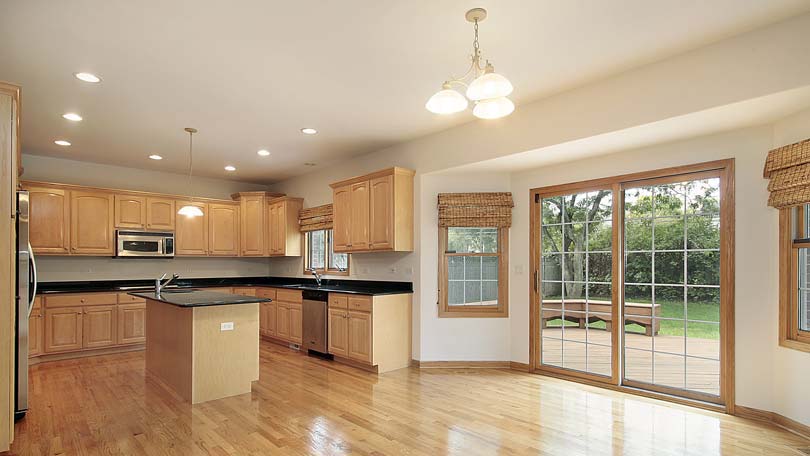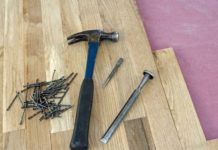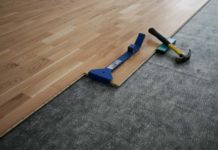
If you’re looking to replace your worn out kitchen floor, you’ll need to weigh many factors, including the durability of your new floor. For every kitchen floor wear and tear is a major issue.
Think about the amount of traffic a busy kitchen encounters — the constant flow of traffic as folks grab food and drink from the refrigerator, the preparation and cooking of daily meals, the washing and storing of dishes, the final steps trod after a visit to the grocery store and much more.
Plus, kitchen floors receive abuse that is as diverse as can be. Along with foot traffic, there are hot, cold, sticky and oily spills, dropped utensils and implements, including pots, pans, knives and dishes and the basic residue that is the result of cooking and cleaning. The kitchen is perhaps the only room in your house that endures almost every type of scenario that defines daily domestic living. It makes sense then that a kitchen floor should be comprised of tough, durable and resilient materials.
This article will consider the major types of floor coverings that are utilized in home kitchens, weighing the pros and cons of each. These include solid wood, engineered wood, plastic laminate, ceramic tile, vinyl and linoleum. Use this article as a starting point from which you’ll be able to engage in research regarding lines that individual manufacturers offer, how their products can serve your needs and what specific choices you have when it comes to style and look.
Solid Wood – In considering kitchen floor wear and tear, solid wood is a good choice as long as it’s treated properly and you choose the right type of wood. Certain hardwoods are recommended, such as hard maple, ash, birch, elm and red oak, while others, like willow, soft maple and alder, are not hearty enough for the kitchen. Solid wood offers a true natural look, attractiveness and warmth. Of all the flooring materials, it is the only one that can be refinished many times. Although solid wood has a reputation for being susceptible to wear and tear, the application of a polyurethane finish goes a long way in solving this problem. Another consideration concerning this floor covering is its sensitivity to standing water and spills. Installing ceramic tile, vinyl or linoleum or adding an absorptive area rug around the sink area, where most spills occur, can help protect the floor while adding a decorative choice. Solid wood scores high when it comes to beauty and gets good marks on wear and tear when the right wood is used, it’s treated with urethane and a protective apron is added around the sink area.
Engineered Wood – If you want the look of solid wood for less money, then engineered wood may be right for you. Along with being less expensive than solid wood, this type of flooring is also easier to install as it can be placed on a foam cushion and floated, glued, nailed or stapled in place. Engineered wood can be refinished once. This material features a wood veneer that is laid over a plywood base. There are some drawbacks when it comes to durability. Dents, wear and tear traffic and spills can eventually damage this kitchen floor covering.
Plastic Laminate – Of the alternatives to solid wood, plastic laminate has quickly become the favorite. Depending upon the quality, this type of flooring often wears better than wood, resisting all sorts of wear and tear, including moisture, dents and scrapes. Overall ease of installation, a wide choice of finishes and a relatively long life expectancy of 15 to 25 years have helped to make this flooring popular. A few words of caution—plastic laminate cannot be refinished and it can suffer major damage when exposed to big spills such as those that might occur if a problem develops in the kitchen with the plumbing, sink or dishwasher.
Ceramic Tile – If you are looking for a kitchen floor that can stand up to the worst of the worst when it comes to wear and tear, then ceramic tile is a great choice. Tile comes in a variety of styles and colors, it coordinates well with kitchen counters, walls and appliances and it is resistant to all sorts of traffic. The downside is installation, which can be difficult. Additionally, ceramic tile does not give at all when someone or something comes in contact with it, which means it can be tough on your feet and joints and on any type of dish, cup or glass that may be dropped. Also, tile has a cold quality that some find unpleasant. Still, this material ranks high when it comes to durability.
Vinyl – If your ultimate concern is resilience and toughness, then vinyl is your best option. Vinyl requires little upkeep, resists just about any abuse you can hurl at it and it’s simple to install. This durable material repulses moisture, spills, stains and even the penetrating UV rays of the sun. If you’re willing to pay the price, you can purchase premium vinyl products that closely mirror slate, stone and tile.
Linoleum – When it comes to kitchen floor wear and tear then linoleum, like vinyl, is also a fine option. Many consumers think that vinyl and linoleum are synonymous but the former is composed of plastic elements while the latter is made from wood products and linseed oil. That means that linoleum is, in essence, comprised of natural materials. Like vinyl, linoleum is resistant to moisture, scratches, dents and UV rays. It is simple to install, comes in a variety of looks and cleans up easily.
Final Considerations
If you’re not concerned about cost and you desire a surface that will resist traffic, spills, cuts and scratches, then ceramic tile is your choice. Linoleum, which has been a veritable standby for years, is still a fine option when it comes to kitchen floor wear and tear and your budget. Vinyl is versatile and tough. Both linoleum and vinyl are available in trendy styles, easy to install and involve little maintenance.
If you want wood or the wood “look,” you have a few choices. Plastic laminate floor covering is a decent selection if you’re concerned about durability and want the styling that wood affords. Engineered wood and solid wood are your two other options. Engineered wood is less expensive than solid wood and a bit more durable. Solid wood will hold up well as long as you choose the right hardwood and it’s treated properly.
In order to make a final decision about your new kitchen floor, you’ll need to research individual manufactures and their products. Be sure to ask sales personnel specific questions concerning durability, upkeep, installation, price and more. When installing flooring the manufacture’s guidelines must be followed or the guarantee will be void.
Finally, consider the impact your new kitchen floor will have on the resale value of your home. Look to purchase quality products that offer value, including style, quality workmanship and longevity.





